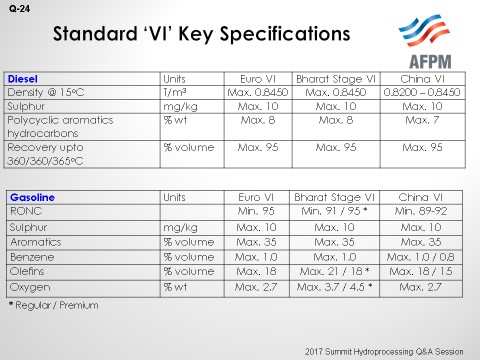Question 24: What are you doing to meet the Euro VI/BS VI/China VI fuel quality specifications for gasoline and diesel product streams?
RAMACHANDRAN (Bharat Petroleum Corporation Limited)
This is a global question, so I will try to give you a broad answer. Looking at the specifications, you will notice that whether it is Euro VI, a Bharat stage VI, or a China VI, the specifications are similar with minor variations. All of them are attempting to get to the 10 ppm (parts per million) level for the sulfur while trying to reduce aromatics and olefins in the fuel. This is the general intent of all the specifications and changes happening globally.

Having said that, each of the refineries has its own processes to consider: the crudes they process, the products they make, and the refinery’s objectives. So, obviously, there have been different routes taken by each of the refineries, depending on the location and some socioeconomic factors. Before I talk about those factors, I want to say that one of the things which really seems to be different from the previous specifications is the need to meet tail pipe emissions standards, which are drastically different than for nitrogen oxides, for example.
When we look at sulfur reduction in diesel, hydrotreatment and hydrocracking have been the obvious choices.
As far as gasoline is concerned, it has always been a struggle to reduce the olefins and increase the octane. Alkylation has been the preferred choice in most places, except in countries where LPG is being used as cooking fuel. For example, in India, the choice seems to be more towards burning it as a fuel than as a feed. Accordingly, you will see a specification difference in the BS VI fuels with respect to their oxygenates content. The global investments have been huge. It is reported that about $7 billion of investment has been made in China to meet the specifications between 2017 and 2020. In India, about $4 billion has been allocated for expenditure in the next few years.
We also see the restlessness with which the refineries are approaching the specifications due to the inherent threat of being out of place in the rapidly changing climatic environment. With this happening as a combination of events, one key parameter refiners are evaluating when trying to meet the specification is how fast they will be able to obtain their return on investments. In the context of electrical vehicles posing, speculatively, a threat somewhere in the future, it remains to be seen if the investments made for these specifications will or will not bear the expected returns.
More importantly, as transportation fuels come under threat of electrical vehicles, there is a strong need for us to know where we are heading, as far as the end results of specifications are concerned.
AL-FUDHAIL (Saudi Aramco)
In terms of Saudi Aramco Refining supplying Euro VI, BS VI, and China VI, there is not much foreseeable demand for these types of specification in fuels locally in Saudi Arabia. There are commitments for Euro V, which we are honoring. However, as a refiner, we are not doing much to meet Euro VI with these types of specification.
JOHNSON (Motiva Enterprises LLC)
The same for Motiva, in terms of Saudi Aramco’s strategy. At this point in time, there is no real push to chase these new specs, as it stands today, in terms of strategy or projects.